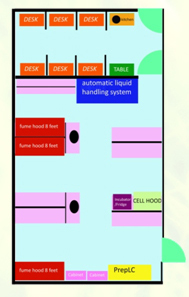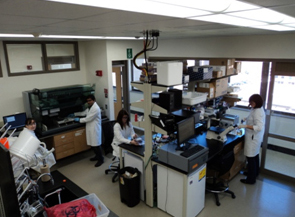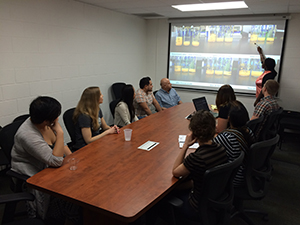
In spring 2009 the design of the Arnold lab was finalized and submitted to the Department of Letters and Science. In collaboration with the UWM architect Bill Stenavich a more detailed scheme wase prepared, which finally lead to the demolition of old laboratory space and the construction of the Arnold Laboratory. The laboratory has 1000 square feet with 70 feet of bench space, two six foot fume hoods, one eight foot fume hood, two sinks and a four foot cell cultur hood. Twenty feet of bench space is occupied by major instumentation described below. |
 |
 |
The construction was completed in January 2010 followed by purchase of instrumentation and consumables. In the summer of 2010, the Arnold Lab had six members and produced the first scientific results. The photo shows our cell culture area equipped with a cell culture hoodand incubator, We have multiple cells lines in culture at any time. For our VDR project, we are using kidney cell lines HCK-7 and postate cancer cell lines DU145 and LnCAP. In the rear of the photo can you can see our analytical section equipped with a LCMS instrument (Thermo) and preparative HPLC system (Gilson) to facilitate the purification and analysis of small molecule libaries generated around our high thoughput screening hit compounds. |
The unique setup of the laboratory provides the necessary infrastructure to allow research in the field of organic chemistry, biochemistry, and analytical chemistry. In the front of the picture you can see our confocal microscope and automated patch clamp instrument from Fluxion to determine the alpha subtype selectivty of imidazobenzodiazepines provided by Dr. Cook. We are using HEK293 cells transiently tranfected with the GABA(A) receptor alpha subunits. The rear of the photo depicts our automated liquid handler from TECAN as well as our M1000 multilabel reader. These instruments are essential for the characterization of bioactivity of newly synthesized compounds and screening hits in various biochemical and cell-based assays. |
 |
 |
Our analytical work is carried out at the Shimadzu Laboratory for Advanced Applied and Analytical Chemistry is a new laboratory housed in UWM’s new Kenwood Interdisciplinary Research Center. Instrumentation includes the following Shimadzu products: MALDI-7090 with AcuSpot and CHIP (MALDI TOF-TOF platform for proteomics, metabolomics, and tissue imaging), LCMS-IT-TOF (hybrid UPLC with integrated ion trap and TOF systems), GCMS QP-2010 Ultra with DI probe, Triple Quad LCMS-8040 (with high speed positive/negative ionization switching), LCMS-2020 single quad, FTIR-IR Tracer NIR/FAR, UV-2600 spectrometer, and a Shimadzu model 8500 ICP-mass spectrometer. |
Adjacent to this laboratory is a 300 square foot office area for students and researchers. This space has seven separate desk areas equipped with laptop computers and high speed internet. We are using the lastest versions of Windows, Microsoft Office, Endnote, Adobe Design Standard, ChemOffice Ultra, MNova, and MOE (Chemical Computing Group). Shared files for group meeting are uploaded to a cloud server. Additional space is provided for a kitchenette with fridge and microwave. Group meetings take place in a new conference room of the MIDD. |
 |
